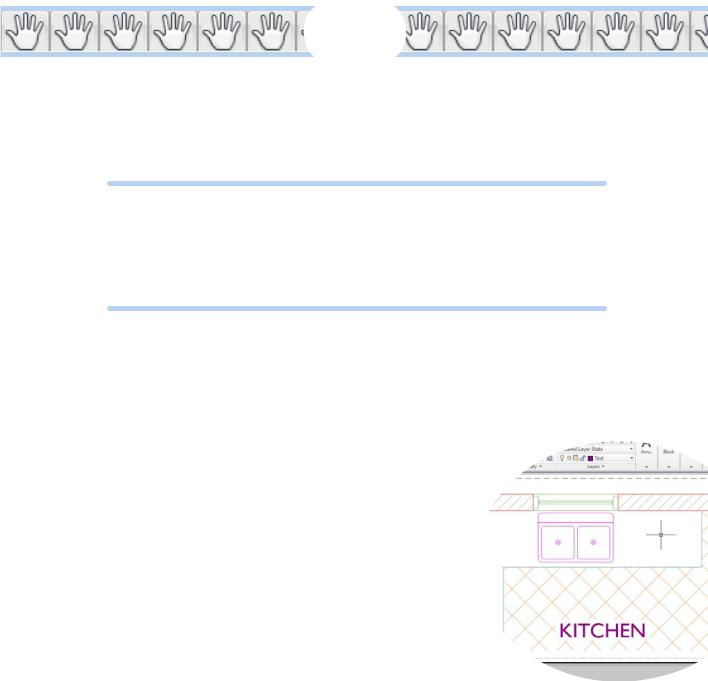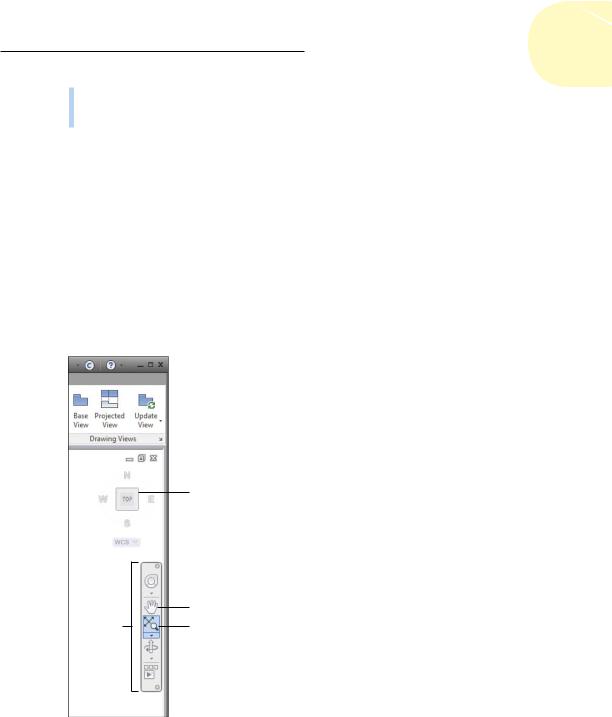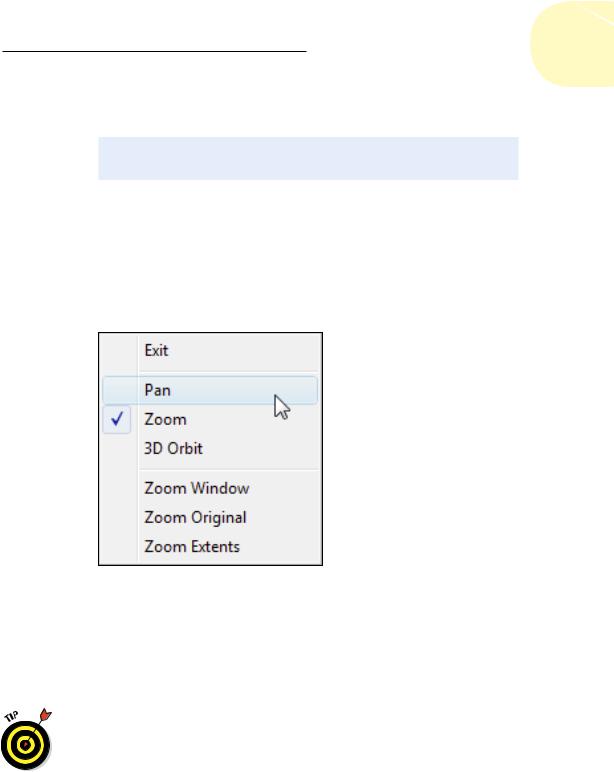
- •About the Authors
- •Dedication
- •Authors’ Acknowledgments
- •Table of Contents
- •Introduction
- •What’s Not (And What Is) in This Book
- •Mac attack!
- •Who Do We Think You Are?
- •How This Book Is Organized
- •Part I: AutoCAD 101
- •Part II: Let There Be Lines
- •Part III: If Drawings Could Talk
- •Part IV: Advancing with AutoCAD
- •Part V: On a 3D Spree
- •Part VI: The Part of Tens
- •But wait . . . there’s more!
- •Icons Used in This Book
- •A Few Conventions — Just in Case
- •Commanding from the keyboard
- •Tying things up with the Ribbon
- •Where to Go from Here
- •Why AutoCAD?
- •The Importance of Being DWG
- •Seeing the LT
- •Checking System Requirements
- •Suddenly, It’s 2013!
- •AutoCAD Does Windows (And Office)
- •And They’re Off: AutoCAD’s Opening Screens
- •Running with Ribbons
- •Getting with the Program
- •Looking for Mr. Status Bar
- •Let your fingers do the talking: The command window
- •The key(board) to AutoCAD success
- •Keeping tabs on palettes
- •Down the main stretch: The drawing area
- •Fun with F1
- •A Simple Setup
- •Drawing a (Base) Plate
- •Drawing rectangles on the right layers
- •Circling your plate
- •Nuts to you
- •Getting a Closer Look with Zoom and Pan
- •Modifying to Make It Merrier
- •Hip-hip-array!
- •Stretching out
- •Crossing your hatches
- •Following the Plot
- •A Setup Roadmap
- •Choosing your units
- •Weighing up your scales
- •Thinking annotatively
- •Thinking about paper
- •Defending your border
- •A Template for Success
- •Making the Most of Model Space
- •Setting your units
- •Making the drawing area snap-py (and grid-dy)
- •Setting linetype and dimension scales
- •Entering drawing properties
- •Making Templates Your Own
- •Setting Up a Layout in Paper Space
- •Will that be tabs or buttons?
- •View layouts Quick(View)ly
- •Creating a layout
- •Copying and changing layouts
- •Lost in paper space
- •Spaced out
- •A view(port) for drawing in
- •About Paper Space Layouts and Plotting
- •Managing Your Properties
- •Layer one on me!
- •Accumulating properties
- •Creating new layers
- •Manipulating layers
- •Using Named Objects
- •Using AutoCAD DesignCenter
- •Copying layers between drawings
- •Controlling Your Precision
- •Keyboard capers: Coordinate input
- •Understanding AutoCAD’s coordinate systems
- •Grab an object and make it snappy
- •Other Practical Precision Procedures
- •Introducing the AutoCAD Drawing Commands
- •The Straight and Narrow: Lines, Polylines, and Polygons
- •Toeing the line
- •Connecting the lines with polyline
- •Squaring off with rectangles
- •Choosing your sides with polygon
- •(Throwing) Curves
- •Going full circle
- •Arc-y-ology
- •Solar ellipses
- •Splines: The sketchy, sinuous curves
- •Donuts: The circles with a difference
- •Revision clouds on the horizon
- •Scoring Points
- •Commanding and Selecting
- •Command-first editing
- •Selection-first editing
- •Direct object manipulation
- •Choosing an editing style
- •Grab It
- •One-by-one selection
- •Selection boxes left and right
- •Perfecting Selecting
- •AutoCAD Groupies
- •Object Selection: Now You See It . . .
- •Get a Grip
- •About grips
- •A gripping example
- •Move it!
- •Copy, or a kinder, gentler Move
- •A warm-up stretch
- •Your AutoCAD Toolkit
- •The Big Three: Move, Copy, and Stretch
- •Base points and displacements
- •Move
- •Copy
- •Copy between drawings
- •Stretch
- •More Manipulations
- •Mirror
- •Rotate
- •Scale
- •Array
- •Offset
- •Slicing, Dicing, and Splicing
- •Trim and Extend
- •Break
- •Fillet and Chamfer and Blend
- •Join
- •When Editing Goes Bad
- •Zoom and Pan with Glass and Hand
- •The wheel deal
- •Navigating your drawing
- •Controlling your cube
- •Time to zoom
- •A View by Any Other Name . . .
- •Looking Around in Layout Land
- •Degenerating and Regenerating
- •Getting Ready to Write
- •Simply stylish text
- •Taking your text to new heights
- •One line or two?
- •Your text will be justified
- •Using the Same Old Line
- •Turning On Your Annotative Objects
- •Saying More in Multiline Text
- •Making it with Mtext
- •It slices; it dices . . .
- •Doing a number on your Mtext lists
- •Line up in columns — now!
- •Modifying Mtext
- •Gather Round the Tables
- •Tables have style, too
- •Creating and editing tables
- •Take Me to Your Leader
- •Electing a leader
- •Multi options for multileaders
- •How Do You Measure Up?
- •A Field Guide to Dimensions
- •The lazy drafter jumps over to the quick dimension commands
- •Dimension associativity
- •Where, oh where, do my dimensions go?
- •The Latest Styles in Dimensioning
- •Creating and managing dimension styles
- •Let’s get stylish!
- •Adjusting style settings
- •Size Matters
- •Details at other scales
- •Editing Dimensions
- •Editing dimension geometry
- •Editing dimension text
- •Controlling and editing dimension associativity
- •Batten Down the Hatches!
- •Don’t Count Your Hatches. . .
- •Size Matters!
- •We can do this the hard way. . .
- •. . . or we can do this the easy way
- •Annotative versus non-annotative
- •Pushing the Boundary (Of) Hatch
- •Your hatching has no style!
- •Hatch from scratch
- •Editing Hatch Objects
- •You Say Printing, We Say Plotting
- •The Plot Quickens
- •Plotting success in 16 steps
- •Get with the system
- •Configure it out
- •Preview one, two
- •Instead of fit, scale it
- •Plotting the Layout of the Land
- •Plotting Lineweights and Colors
- •Plotting with style
- •Plotting through thick and thin
- •Plotting in color
- •It’s a (Page) Setup!
- •Continuing the Plot Dialog
- •The Plot Sickens
- •Rocking with Blocks
- •Creating Block Definitions
- •Inserting Blocks
- •Attributes: Fill-in-the-Blank Blocks
- •Creating attribute definitions
- •Defining blocks that contain attribute definitions
- •Inserting blocks that contain attribute definitions
- •Edit attribute values
- •Extracting data
- •Exploding Blocks
- •Purging Unused Block Definitions
- •Arraying Associatively
- •Comparing the old and new ARRAY commands
- •Hip, hip, array!
- •Associatively editing
- •Going External
- •Becoming attached to your xrefs
- •Layer-palooza
- •Creating and editing an external reference file
- •Forging an xref path
- •Managing xrefs
- •Blocks, Xrefs, and Drawing Organization
- •Mastering the Raster
- •Attaching a raster image
- •Maintaining your image
- •Theme and Variations: Dynamic Blocks
- •Lights! Parameters!! Actions!!!
- •Manipulating dynamic blocks
- •Maintaining Design Intent
- •Defining terms
- •Forget about drawing with precision!
- •Constrain yourself
- •Understanding Geometric Constraints
- •Applying a little more constraint
- •AutoConstrain yourself!
- •Understanding Dimensional Constraints
- •Practice a little constraint
- •Making your drawing even smarter
- •Using the Parameters Manager
- •Dimensions or constraints — have it both ways!
- •The Internet and AutoCAD: An Overview
- •You send me
- •Send it with eTransmit
- •Rapid eTransmit
- •Bad reception?
- •Help from the Reference Manager
- •Design Web Format — Not Just for the Web
- •All about DWF and DWFx
- •Autodesk Design Review 2013
- •The Drawing Protection Racket
- •Autodesk Weather Forecast: Increasing Cloud
- •Working Solidly in the Cloud
- •Free AutoCAD!
- •Going once, going twice, going 123D
- •Your head planted firmly in the cloud
- •The pros
- •The cons
- •Cloudy with a shower of DWGs
- •AutoCAD 2013 cloud connectivity
- •Tomorrow’s Forecast
- •Understanding 3D Digital Models
- •Tools of the Trade
- •Warp speed ahead
- •Entering the third dimension
- •Untying the Ribbon and opening some palettes
- •Modeling from Above
- •Using 3D coordinate input
- •Using point filters
- •Object snaps and object snap tracking
- •Changing Planes
- •Displaying the UCS icon
- •Adjusting the UCS
- •Navigating the 3D Waters
- •Orbit à go-go
- •Taking a spin around the cube
- •Grabbing the SteeringWheels
- •Visualizing 3D Objects
- •Getting Your 3D Bearings
- •Creating a better 3D template
- •Seeing the world from new viewpoints
- •From Drawing to Modeling in 3D
- •Drawing basic 3D objects
- •Gaining a solid foundation
- •Drawing solid primitives
- •Adding the Third Dimension to 2D Objects
- •Creating 3D objects from 2D drawings
- •Modifying 3D Objects
- •Selecting subobjects
- •Working with gizmos
- •More 3D variants of 2D commands
- •Editing solids
- •Get the 2D Out of Here!
- •A different point of view
- •But wait! There’s more!
- •But wait! There’s less!
- •Do You See What I See?
- •Visualizing the Digital World
- •Adding Lighting
- •Default lighting
- •User-defined lights
- •Sunlight
- •Creating and Applying Materials
- •Defining a Background
- •Rendering a 3D Model
- •Autodesk Feedback Community
- •Autodesk Discussion Groups
- •Autodesk’s Own Bloggers
- •Autodesk University
- •The Autodesk Channel on YouTube
- •The World Wide (CAD) Web
- •Your Local ATC
- •Your Local User Group
- •AUGI
- •Books
- •Price
- •3D Abilities
- •Customization Options
- •Network Licensing
- •Express Tools
- •Parametrics
- •Standards Checking
- •Data Extraction
- •MLINE versus DLINE
- •Profiles
- •Reference Manager
- •And The Good News Is . . .
- •APERTURE
- •DIMASSOC
- •MENUBAR
- •MIRRTEXT
- •OSNAPZ
- •PICKBOX
- •REMEMBERFOLDERS
- •ROLLOVERTIPS
- •TOOLTIPS
- •VISRETAIN
- •And the Bonus Round
- •Index

12
A Zoom with a View
In This Chapter
Zooming and panning
Naming and restoring views
Zooming and panning in paper space layouts
Regenerating the display
One of AutoCAD’s advantages over manual drawing is its ability to show you different views of your drawing. You can zoom in close, zoom out
to a great distance, and pan around. In fact, not only can you zoom and pan in your drawing, but in most kinds of drawings, you must also do it frequently to be able to draw and edit effectively.
Technical drawings are jam-packed with lines, text, and dimensions. Zooming and panning frequently enables you to see
the details better, draw more confidently (because you can see what you’re doing), and edit more quickly (because object selection is easier when there aren’t
a zillion objects on the screen). This chapter covers AutoCAD’s most useful display control features.
Zoom and Pan with Glass and Hand
Moving your viewpoint in to get a closer view of your drawing data is called zooming in; moving your viewpoint back to get a more expansive view is called zooming
out. Moving your viewpoint to another part of your drawing without zooming in or out is called panning.
Changing your viewing position lets you do detailed work on tiny objects and then zoom out and move around rooms, houses, or neighborhoods from an Olympian perspective. Early versions of AutoCAD included a sample drawing
www.it-ebooks.info

244 Part II: Let There Be Lines
of our solar system, drawn to scale with kilometers as units, which proved this. If you zoomed all the way out, you could see Pluto’s orbit (yes, kids, Pluto was a planet back then), and you could zoom in close enough to Earth’s moon to read the inscription on the plaque left by the Apollo 11 astronauts!
In fact, AutoCAD’s zoom range is far more impressive than this. AutoCAD can draw a circle with a radius of 1098 units, but the radius of the known (so far) universe is “only” about 8.2 x 1021 miles. At the other end of the range, it can draw a circle with a radius of 10-98 units, versus the Lorentz or “standard” radius of an electron of about 1.1 x 10-12 inches.
Panning means changing your viewing position without changing the magnification of the view. If you zoom in enough that some of your drawing no longer shows up onscreen, you’re going to want to pan around — move left, right, up, and down in your drawing — without zooming in and out. AutoCAD makes panning easy with scroll bars and realtime panning. And in case you’re wondering what realtime panning might be (as opposed to pretendtime panning, maybe?), it simply means you can see the objects moving around the screen as you drag the mouse up and down or back and forth. (Of course, it’s your viewpoint that’s moving, not the objects!)
Both panning and zooming change the view — the current location and magnification of the AutoCAD depiction of your drawing. Each time you zoom or pan, you establish a new view. You can give a name to a specific view to make returning to that view easy, as we demonstrate in the section “A View by Any Other Name . . . ,” later in this chapter.
You’ll get a better sense of panning and zooming around a drawing if you actually have a drawing to look at. Draw some objects on the screen, open one of your own existing drawings, or launch one of AutoCAD’s sample drawings. (If you haven’t done so already, you can download the sample files from
www.autodesk.com/autocad-samples; the AutoCAD LT sample files are also online at www.autodesk.com/autocadlt-samples.)
The wheel deal
Later in this chapter, we cover AutoCAD’s various commands and options for panning and zooming in more detail. On the other hand, if you have a wheel mouse, you’ll rarely need to use other methods, especially when working in 2D drawings. If you don’t have a wheel mouse, you should run out and buy one because the slight cost will be more than offset by your increased productivity. The following three actions will usually suffice for almost all your panning and zooming needs.
To zoom in and out: Roll the scroll wheel forward and backward.
To pan: Many people don’t know that the scroll wheel is also a button. To pan, hold down the scroll wheel as you move the mouse.
www.it-ebooks.info

Chapter 12: A Zoom with a View 245
To zoom to the extents of your drawing: Double-click the scroll wheel. This is particularly useful when you don’t heed the warnings in Chapter 11 about when to press Enter during a Move or Copy.
Navigating your drawing
You may think that AutoCAD is all about drawing, and maybe, occasionally, even about erasing. In that case, it may surprise you to learn that two of the most frequently used commands in all of AutoCAD are PAN and ZOOM. These commands and a few others can be found on an interface component called
the Navigation bar.
The Navigation bar is linked by default to another interface component named the ViewCube. (AutoCAD LT users get the Navigation bar, but not the ViewCube.) Figure 12-1 shows the upper-right corner of the AutoCAD window with the ViewCube and Navigation bar in their default locations.
ViewCube
Pan
Navigation Zoom split button bar
 Navigation bar menu
Navigation bar menu
Figure 12-1: Belly up to the Navigation bar.
www.it-ebooks.info

246 Part II: Let There Be Lines
We fill you in on the ViewCube in Chapter 21, since it’s a more useful tool in three dimensions than in two. We also cover the SteeringWheels and ShowMotion commands (the latter isn’t present in AutoCAD LT) in Part V of this book.
Controlling your cube
Apart from the big chunk of screen space the ViewCube and Navigation bar occupy, the cube itself has some disconcerting behaviors. If you click the Home button, for example, you automatically switch to a preset 3D isometric view — not that helpful if you’re doing a 2D drawing. Worse yet, any of the side views just show you the edge of your 2D drawing.
We think the cube-bar combo is worthwhile when you’re doing 3D modeling, but more intrusive than useful for 2D drafting. Luckily, AutoCAD offers quite a bit of control over both the ViewCube and the Navigation bar. You can turn off the navigation buttons you don’t use, and you can turn off the ViewCube itself, either for the drawing session or permanently.
To turn off navigation buttons: Open the Navigation bar’s menu by clicking the down arrow at its bottom-right corner (refer to Figure 12-1) and deselecting SteeringWheels, Orbit, and ShowMotion.
To turn off the ViewCube in the current viewport: Go to the View tab’s Windows panel, click User Interface, and deselect ViewCube. Reverse the procedure to turn it on again.
To turn off the ViewCube permanently: Open the Options dialog box, and select the 3D Modeling tab. In the Display Tools in Viewport area, deselect 2D Wireframe Visual Style and All Other Visual Styles under Display the ViewCube.
In addition to the Navigation bar, the Navigate and Navigate 2D panels of the Ribbon’s View tab contains a Pan button and a drop-down set of Zoom tool buttons (in our opinion, not a very convenient location for such frequently used commands!).
AutoCAD offers 11 different ways of zooming around in your drawing; a wheel mouse can fulfill most of your needs, but we explain the most important of the other methods in the next section. The following steps describe how to use AutoCAD’s Zoom and Pan Realtime feature, which is easy to operate and provides a lot of flexibility:
1.Click the lower part of the Zoom split button on the Navigation bar and choose Zoom Realtime from the menu.
www.it-ebooks.info

Chapter 12: A Zoom with a View 247
The Realtime option of the ZOOM command starts. The crosshairs change to a magnifying glass, and AutoCAD prompts you at the command line:
Specify corner of window, enter a scale factor (nX or nXP), or [All/Center/
Dynamic/Extents/Previous/Scale/Window/Object] <real time>:
Press ESC or ENTER to exit, or right-click to display shortcut menu.
2.Move the magnifying glass cursor near the middle of the screen, press and hold down the left mouse button, and drag the cursor up and down until the objects you want to see almost fill the screen.
Dragging up increases the zoom magnification, and dragging down decreases it.
3.Right-click in the drawing area and choose Pan from the menu that appears (as shown in Figure 12-2).
Figure 12-2: The Zoom/Pan Realtime right-click menu.
The magnifying glass cursor changes to a hand.
(Because AutoCAD LT doesn’t do 3D, there’s no 3D Orbit choice on LT’s right-click menu.)
4. Click and drag to pan the drawing in any direction.
You can use the right-click menu to toggle between Zoom and Pan as many times as you like. If you get lost in your drawing, choose Zoom Original or Zoom Extents to return to a more familiar view.
www.it-ebooks.info
